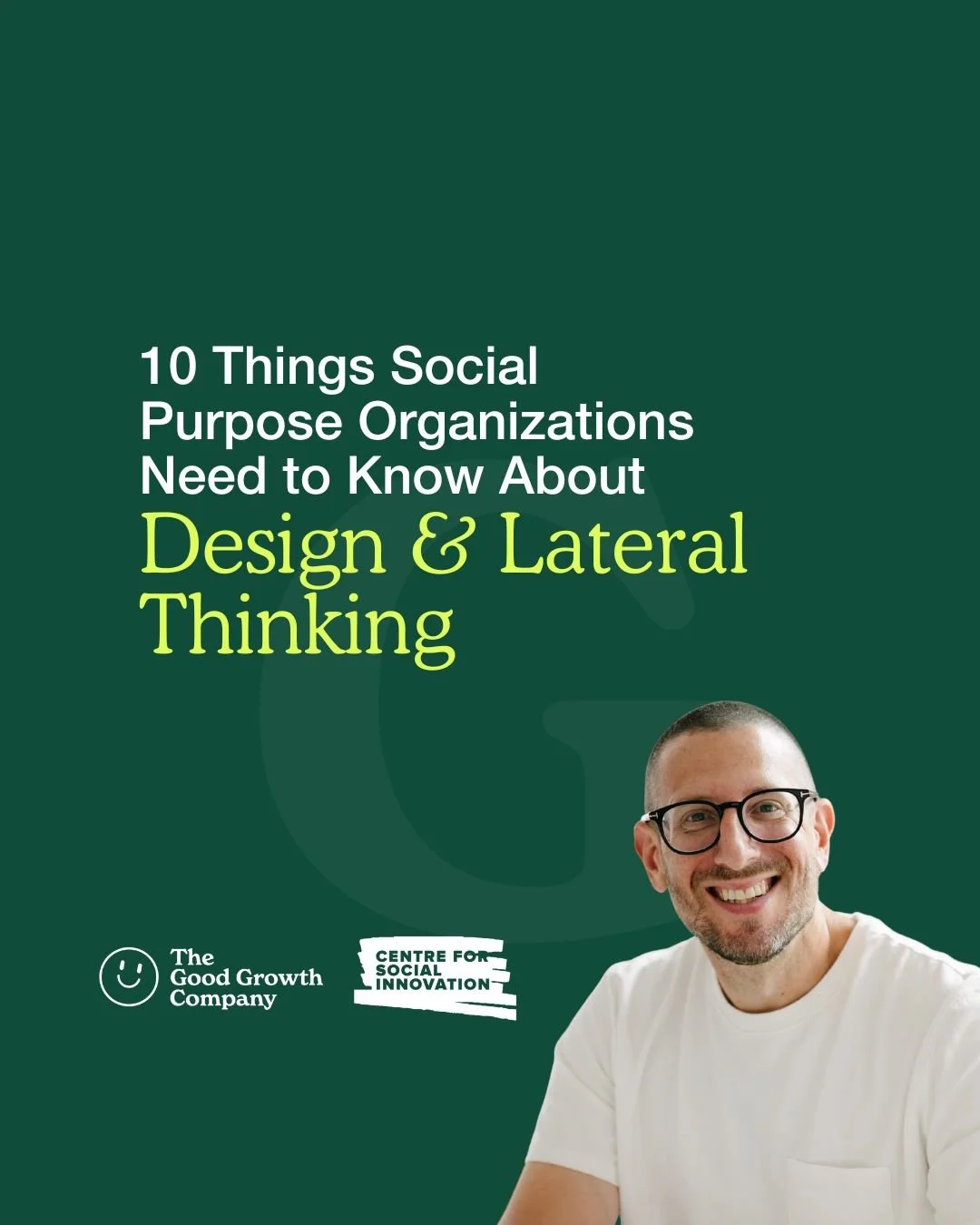How Design Thinking & Lateral Thinking Can Help Social Purpose Leaders
Design isn’t a department — it’s a way of solving problems. In our latest 10 Things session, product & innovation consultant Jason Goodman showed charities and social-purpose teams how to turn constraints, ambiguity, and competing priorities into real momentum. Drawing on 17 years across startups, enterprise, health, and the UN ecosystem, Jason unpacked practical tools you can use this week—no jargon, no gatekeeping, just repeatable habits that lead to better ideas, better alignment, and better outcomes.
Top Takeaways
Creativity is a skill—practice it on purpose.
Most people overestimate “talent” and underestimate reps. Treat creative thinking like a muscle you train, not a lightning bolt you wait for. Build micro-routines that force you to think differently every day.
You have time for innovation—time-box it.
Run Jason’s 6-minute ideation drill: 2 minutes to list ideas, then 2 minutes to double that number, then 2 more minutes to double again. Ten people can generate ~240 ideas in six minutes. Use a simple grid on paper and symbols/stick figures—speed kills self-censorship.
Design thinking is just a cycle—run it.
Frame the question → gather inspiration → synthesize → generate → prototype → test/learn → share the story. Don’t wait for permission; iterate the loop with what you have.
Storytelling is an innovation tool.
Want different answers? Start with different stories. Describe a vivid future outcome (e.g., a radically better shelter experience), then reverse-engineer “what would need to be true.” Bring stories into board and team meetings on purpose.
Design with people, not for them.
Co-creation isn’t a “nice to have.” If the people you serve aren’t shaping the solution, you’re guessing—and you’ll miss. Build mechanisms to listen, prototype together, and course-correct early.
Constraints are catalysts.
Budget, policy, timing, politics—name your elephants and put them on the table. Clear constraints focus ideas, making them more grounded and useful.
Make it visible to make it collaborative.
High-performing teams artifact thinking: draw, sketch, whiteboard, map assumptions. “To get on the same page, you need a page.” Visuals stop people from talking past each other.
Every system is perfectly designed for its results.
If you don’t like the outcomes, redesign the system—roles, rituals, incentives, and rhythms—not just the messaging. That starts with honest reflection about what’s truly changeable.
When you’re short on ideas, ask better questions.
Interrogate default words like “help” and “better.” Shared language creates shared direction; vague terms kill alignment, innovation, and impact.
Slow down to go faster.
Two weeks of alignment can save months of rework. Plan deliberately, then execute smoothly. Consider role-swaps across teams (marketing solves design’s problems, etc.) to reframe challenges.
Practical Plays You Can Run This Month
6-Minute Idea Sprint: Open every weekly stand-up with the grid exercise on one sticky problem. Vote, cluster, and pick 1–2 micro-tests to run before the next meeting.
Story-First Strategy Review: Begin your next leadership or board meeting with a 3-minute future story from a beneficiary, volunteer, or partner. Ask: What must be true for this to be normal here? Capture assumptions to test.
Co-Design Sessions: Convene a 60-minute workshop with service users. Sketch three scrappy prototypes (screens, scripts, or service blueprints), get live feedback, and decide the next small test.
Constraints Charter: List your five biggest constraints. Reframe each as a design brief (“Given X, how might we Y?”). Prioritize the ones that sharpen focus.
Role-Swap Jam: Once a quarter, switch departments for an ideation hour. New angles unlock blind spots and reframe problems in surprisingly useful ways.
Top Quotes from Jason
“Creativity is a skill you can develop.”
“Storytelling deserves more respect [as an innovation tool].”
“Social purpose organizations will fail if they design for people instead of with people.”
“When you don’t have good constraints, it’s very difficult to innovate.”
“Every system is perfectly designed to get the result it gets.”
“I’m a big believer in slowing down to then go faster.”
Why this matters now
Nonprofits and social enterprises feel the pressure to “do more with less.” Jason’s point is refreshing: you don’t need more hours—you need better cycles. Tighten your questions, involve your community, visualize thinking, and let constraints sharpen the solution. The compounding effect is real.
Want the full recording?
This session is part of The Good Growth Company’s 10 Things series. Library subscribers get access to all past trainings, templates, and upcoming sessions. Access the full Library here.

